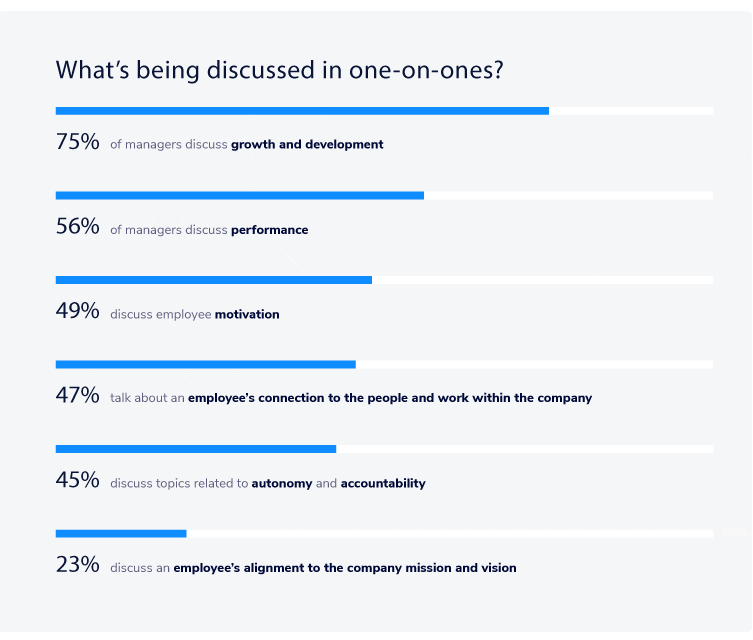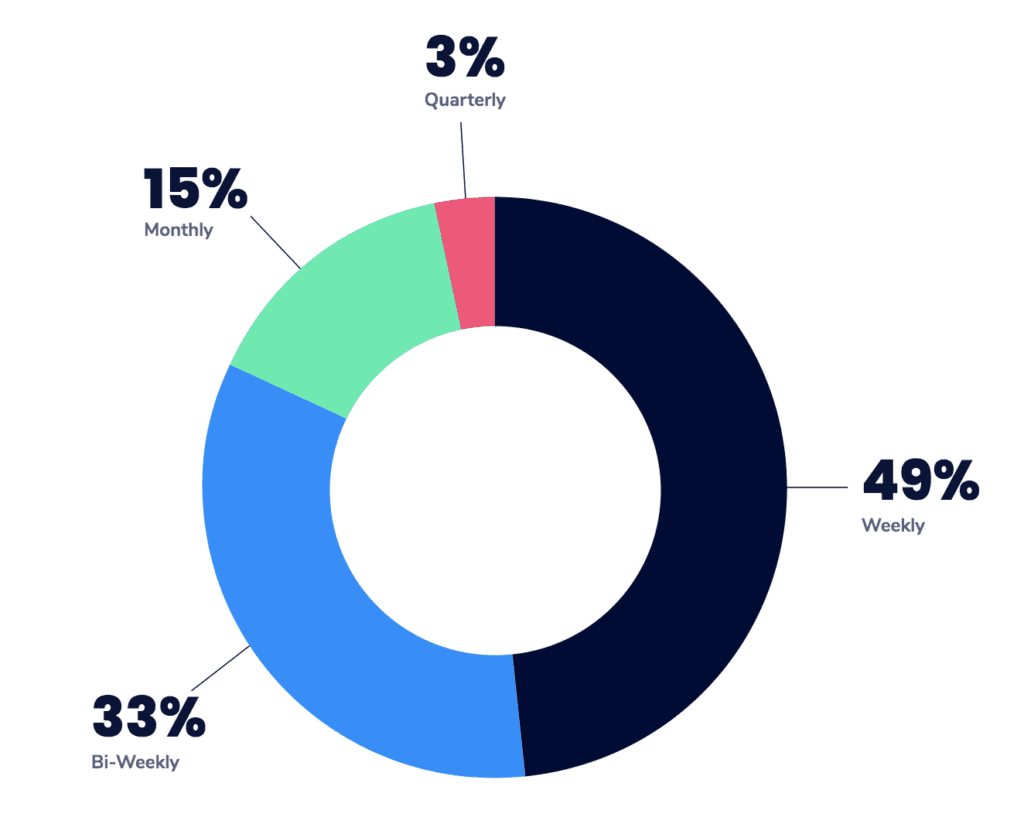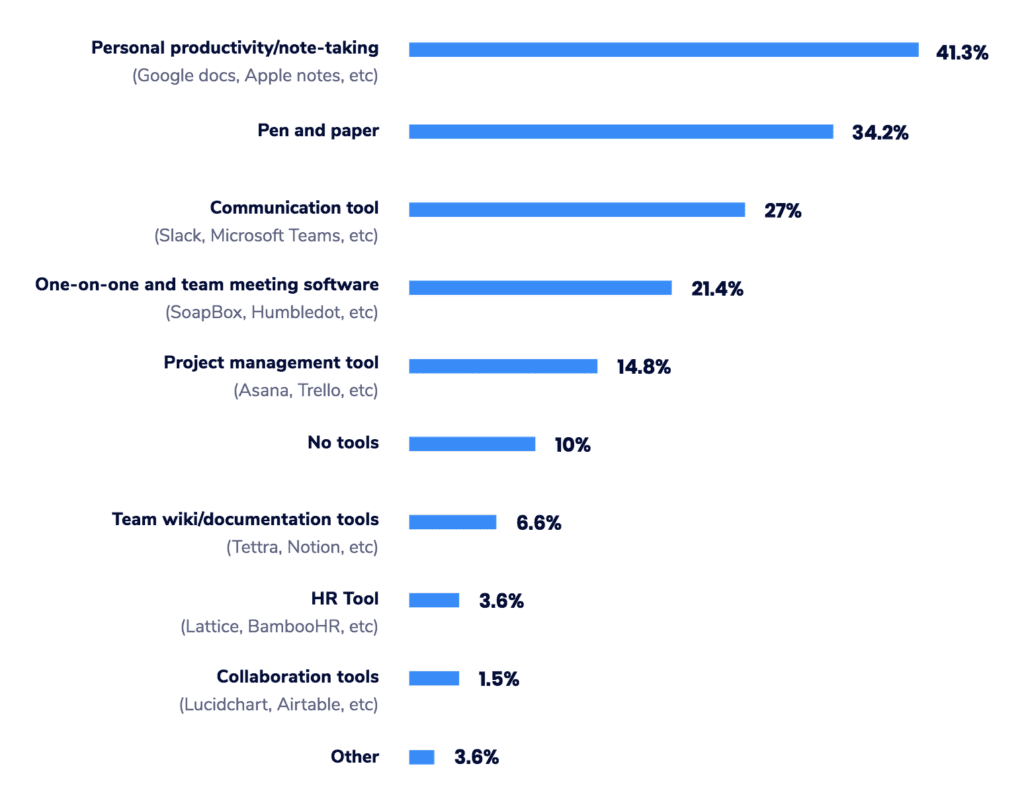Report: The State of One-on-ones
We have put together some key findings from our 2019 State of One-on-ones report.
Warning: Undefined array key "category" in /www/hypercontext_216/public/wp-content/themes/Soapbox/hype-files/sections/article/content.php on line 10
Managers are the unsung heroes in today’s workforce. They’re the main driver of an employee’s happiness, performance and engagement at work. For the past 20 years, managers have accounted for at least 70% of the variance in employee engagement scores. On top of that, a study by TinyPulse found that 40% of employees who did not rate their manager’s performance highly had interviewed for a new job in the last three months, compared to just 10% for those who rated their manager highly.
It’s proven that managers have the most power to influence whether or not an employee is engaged. And while there are many factors that separate a great manager from a bad one, we focused this study on the meetings where managers have the greatest ability to engage their team: one-on-ones.
The 2019 State of One-on-ones analyzes how 200+ managers across multiple industries, tenure and more approach one-on-one meetings. Some of the key aspects covered include:
- Purpose and goals of one-on-one meetings
- How remote managers have one-on-one meetings vs. onsite managers
- How different departments approach one-on-ones
- How organization size and industry affects one-on-ones

“Most managers start their people leadership journeys with zero training. Zero coaching, zero tools and zero experience. They’re left to their own devices to figure out an entirely new set of skills: leading others.
After 10 years in the management space, we’ve learned that the biggest opportunity a manager has to impact the performance and engagement of an employee is during one-on-one meetings.
We’ve also learned that for many managers, this time is often disorganized and unproductive. But how can we help a group of under-serviced super-powerful people in today’s workplace level-up their one-on-ones?
That’s why we’ve put together this report. We believe the findings in this report are extremely important for new and existing managers looking to find their groove. We’re aiming to understand the state of management through the one-on-one lens and hope that as a result, managers reading this can build on the patterns that have proven successful for others.”
–Brennan McEachran, Co-Founder and CEO, SoapBox
If you’re keen to see all of the results, go directly to the State of One-on-ones.
If you’d like to jump right to our key findings, read on:
- 75% of managers discuss growth and development within their one-on-one meetings.
- Remote managers experience more team-related challenges, whereas onsite managers experience more personal productivity challenges.
- Managers most commonly have one-on-ones weekly.
- 41% of managers use personal productivity tools to facilitate one-on-one meetings.
75% of managers discuss growth and development within their one-on-one meetings.

Conversations around growth and development are critical to understanding how a direct report is feeling about their role and how they would like to progress within an organization. In fact, Gallup’s State of the Global Workplace found that when employees receive performance feedback consistently, they become emotionally and psychologically attached to their work and workplace. As a result, employees are more productive and perform at a higher caliber.
What’s shocking about this statistic is that 25% of managers don’t discuss growth and development with their direct reports, which will result in actively disengaging them in the workplace.
If you find yourself stuck in the 25%, or if you’re looking for more ways to discuss growth and development with your direct reports, check out these 21 one-on-one questions.
Remote manager challenges are more team-related vs. onsite managers are personal productivity-related.
Comparing the top challenges that remote and onsite managers face, it is evident that while onsite managers struggled with personal productivity, remote managers struggled with team-related challenges.

Personal productivity challenge: Juggling managing my team with my other responsibilities
72% of onsite managers felt this was their biggest challenge versus 39% of remote managers.
How managers can address this challenge:
Build your team’s skills up so that you’re able to trust them with bigger tasks and more responsibility. And then, actually trust them. This will allow you to delegate more of your work and can help ease this challenge.
Team-related challenge: Getting my team to collaborate with one another.
22% of remote managers felt this was their biggest challenge versus 10% of onsite managers.
How managers can address this challenge:
Focus on fostering a culture of communication amongst your team. Make sure all remote and on-site employees know that communicating with the team is a part of their role and try incorporating things like team-specific Slack channels, or video stand-up meetings to encourage this behavior.
Team-related challenge: Retaining my employees.
17% of remote managers felt this was their biggest challenge versus 3% of onsite managers.
How managers can address this challenge:
Meet frequently with your team in both one-on-one and team settings. This will allow you to continuously gauge how engaged your team is and how you can help keep them engaged.
As a manager, one of the most important parts of your role is communication. When you become a remote manager, the importance of communication is amplified. So, put a lot of time and effort into becoming the best communicator for your direct reports. A great place to start is during your next remote one-on-one meeting.
Most managers have one-on-ones weekly.

Regardless of tenure, count of direct reports, company size, industry or department, managers most commonly have one-on-ones on a weekly basis. Of the 48% who have one-on-ones weekly, 59% have them for 30 minutes.
There are so many things that you can cover during your one-on-one meetings. If you’re unsure where to start or what to ask, check out these 6 tried and tested one-on-one meeting templates.
41% of managers use personal productivity tools to facilitate one-on-one meetings.
*Survey respondents were able to select multiple answers.

What’s surprising here is that 41% of managers use personal productivity tools. However, a one-on-one isn’t about you, the manager, but rather about your direct report. So why use a tool that’s purpose-built to make you more productive, rather than provide both you and your report with the support needed to have a productive conversation.
If you feel like your one-on-one meetings can be improved, take the time to research the purpose-built tools that are available to you. Consider tools that integrate with your current tech stack to reduce any friction.
To learn more about how over 200 managers approach their one-on-one meetings, check out the full report here.
As seen on HRMorning, G2, HR Dive and more!
What you should do now
Next, here are some things you can do now that you've read this article:
- Our library of meeting agenda templates is designed to help you run more effective meetings.
- You should try Spinach to see how it can help you run a high performing org.
- If you found this article helpful, please share it with others on Linkedin or X (Twitter)
